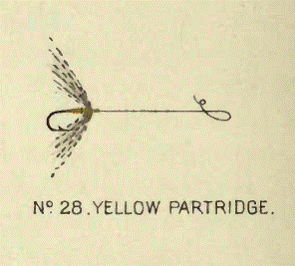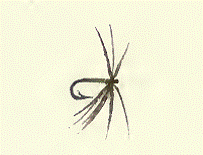Page 1 of 2
First "proper" Soft Hackle
Posted: Tue Dec 04, 2012 8:05 pm
by Dwclapp
A couple weeks ago I posted a thread asking about use of silk in tying soft hackles (Thread
http://www.flymphforum.com/viewtopic.php?f=5&t=3894)
Well, after waiting a couple weeks for my forst few spools of Pearsall's Gossamer Silk Thread to arrive (holidays affected shipping) I have finally and tied my very first fly with silk.
Partridge and yellow (sorta)

Hook: Alec Jackson Crystal Soft Hackle Sz 11
Body: Pearsall's Gossamer Silk thread in Primrose Yellow
Thorax: Muskrat fur (Guard hairs removed)
Hackle: Shoulder feather from Hungarian Partridge
A few problems -
1. Hackles too long
2. Head too large
3. Too much ribbing in the body (thread wraps show). How does one get it to lay flat? Untwist before wrap?
4. Too many hackles.
What else??? Critiques can only make me better at this.
Thanks,
Darin
Re: First "proper" Soft Hackle
Posted: Tue Dec 04, 2012 8:35 pm
by Dwclapp
Wow... just re-read my post. Sorry I didn't proofread it prior to posting. That second section should read:
Well, after waiting a couple weeks for my first few spools of Pearsall's Gossamer Silk Thread to arrive (holidays affected shipping) I have finally received them, had some free time and was able to sit down to tie my very first fly with silk.
Re: First "proper" Soft Hackle
Posted: Tue Dec 04, 2012 8:39 pm
by Mataura mayfly
First off, I think this is a great fly. If my first attempts had looked this good (and some of my current for that matter!

) I could have shaved years off of my tying resume.
Second, all your own critiques could be seen by others as attributes. I read somewhere hackle length for a soft hackle should be 1 1/2 X the width of the hook gape, looks like your pretty close there and I do not believe there are soft hackle police with gauges that are going to come measure. Tie some more with shorter hackle, some more still with longer- variety is the spice of life, but can also mean the difference between a good day and a great day with some fussy fish. Once you have found the hackle length/ body type and colour they like on one day, the next they might like longer and fuller.
With silk it is easy to build bulk and you have to learn how few wraps it takes to hold a material or perform a whip finish to get really good at heads. I still build ugly heads.... fish don't care.
Ribbing of the thread wraps is good, not too many aquatic insects are dead flat tapered bodies. You can un-twist the silk to get it to lay flat, or wax and burnish the body after wrapping..... but again, for a fishing fly your tie is just fine.
Too many wraps? Well maybe, but if you feel you are not getting takes on the water because of too much hackle fibre, you can clip or pinch some out..... just try adding some in..... that's a bit harder.
I feel you deserve top marks for a first silk fly, tie some more, have fun doing it, share the results and pretty soon you will be tying flies you find hard to critique yourself.

Re: First "proper" Soft Hackle
Posted: Tue Dec 04, 2012 8:52 pm
by fflutterffly
I'd bite into that fly if I were wagging my tail up stream!!!! Oh Yeah! Nice work.
Re: First "proper" Soft Hackle
Posted: Tue Dec 04, 2012 8:54 pm
by redietz
Dwclapp wrote:
A few problems -
1. Hackles too long
2. Head too large
3. Too much ribbing in the body (thread wraps show). How does one get it to lay flat? Untwist before wrap?
4. Too many hackles.
Not necessarily on any of those counts. If by "proper" you mean in the original North Country style, take a look at these two Partridge and Yellows from the Old (Pritt) and New (Edmonds and Lee) Testaments of that style:


(The first is a painting, the second is an actual photo, but the pdf is a bit off.)
Notice that the hackles are as long or longer than on you fly. Remember, these don't represent legs, but wings, legs and tail. Anything between about half the hook length to one and a half times the hook length is fair game, your own taste makes the final decision.
Although the particular examples shown don't have large heads, many of the older wet flies did, both because it was needed to hold the gut snell onto the hook, and because real insects have large> Many mayflies have large orange or yellow eyes, what better way to represent that? Again, it's personal taste.
Segment is good. You're not trying to get a floss-like finish.
Again, number of hackle barbs is a matter of taste. Refer again to pictures, and realize that the barbs tend to pull off of game bird hackles as they're fished. Land a few trout on that fly, and it will look like too few.
A very nice first attempt. I'd fish that fly in a minute.
Re: First "proper" Soft Hackle
Posted: Tue Dec 04, 2012 9:06 pm
by Roadkill
Great fly worthy to wave in front of any trout I know.

Re: First "proper" Soft Hackle
Posted: Tue Dec 04, 2012 9:13 pm
by chase creek
I'll second everything Jeff (Mataura Mayfly) said. Pretty darn good for your first stab at it. The hackle looks fine to me. I have a tendency to be heavy handed with hackle, but on some patterns it just looks right to me.
I'd fish your pattern anytime. Nice work.
Re: First "proper" Soft Hackle
Posted: Tue Dec 04, 2012 9:55 pm
by letumgo
Darin - You have gotten excellent feedback. Your fly is a lot better than my first attempt at tying a soft hackle fly with silk thread. My head was bigger, lumpier, and the body work was not nearly as smooth and even. You've gotten off the a very good start, and your results will improve with practice. I like your choice of hook. The silver finish of the crystal hook will help reflect light back thru the body material when it gets wet. It is important to remember that silk thread becomes very translucent when it gets wet. Light color of silk will tend to darken, when tyed on a bronze colored hook. The silver hook will help maintain the light yellow color of the silk. If you have any wax (bees wax, cobblers wax, or regular dubbing wax), you can conduct a simple experiment to see how the color of the silk changes after being waxed. Look carefully at the flies and then wet the bodies with a drop of water. Get a feel for how the color changes, and you will begin to see how these flies can easily be adapted to match specific insect colors, just by making a few simple changes (hook color, waxing, unwaxed, etc.).
If I were to offer one bit of advice, it would be to tye the hackle in by the stem, as close to the eye of the hook as you can. With practice, you should be able to secure the hackle stem within two wraps of the hook eye. When the body and thorax are finished, wrap the hackle back towards the thorax and then wrap the thread forward thru the hackle. A simple three turn whip finish should be all that is needed to complete the fly. I strongly recommend watching Hans Weilenmann's or Davie McPhail's fly tying videos on You Tube. They are both master fly tyers and have excellent tying videos, which should shorten your learning curve.
http://www.youtube.com/user/HansWeilenm ... eos?view=0
http://www.youtube.com/user/DavieMcPhail/videos?view=0
Re: First "proper" Soft Hackle
Posted: Tue Dec 04, 2012 11:21 pm
by hankaye
Dwclapp, Howdy;
Fantastic first Flymph!...
The previous comments have covered all the bases.
Well Done.
hank
Re: First "proper" Soft Hackle
Posted: Wed Dec 05, 2012 7:52 am
by Hans Weilenmann
Darin,
Excellent start. Well done.
You have received many good suggestions and there is no point in me repeating them.
I would like to home in on the body wraps. It is important you understand that Pearsall's Gossamer structure is different from the synthetic threads you are familiar with.
These threads (Danville Flymaster, UTC, Benecchi, etc) are a single 'rope' of basically parallel filaments, then twisted somewhat to hold the rope together. You can, as desired, add additional twists to make a round rope, or untwist to flatten. (Uni is a little bit of an oddball in that a bonding agent is added to the filaments. Uni
can be flattened, but that requires you first to break the bond.)
Pearsall's Gossamer silk is made up of three twisted ply's, three individual 'ropes'. These in turn are lightly twisted. While you can untwist the three ply's and have them wrap side by side, you will not have them wrap as smooth as with flattened, say, Benecchi.
You can observe the Pearsall's Gossamer structure quite clearly in this image

Cheers,
Hans W




